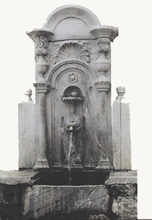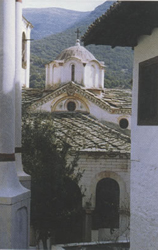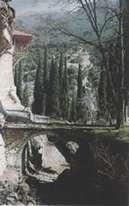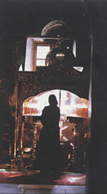The monastery's well. In 1571 the Turks sacked the monastery despite it being under the protection of the Sultans. The monastery was abandoned once more in 1650 and again in 1729 due to insuperable difficulties. In 1764 the Ecumenical Patriarch handed the monastery over to Patriarch Seraphim the Second as a personal retreat.The contribution of the Monastery's monks to the revolutionary movement of 1821 was considerable. The younger monks fought alongside Emmanouil Papa and the monastery aided the struggle through the provision of supplies.A spiritual centre through the centuries, the monastery of the Timios Prodromos was a leading light for patriots in Serres. The monastery also started a Greek School on their own initiative, which ran as their responsibility in specially designed premises within the monastery, and which bolstered National Consciousness among young people in the Serres area during the difficult years of Turkish slavery and the Macedonian Struggle.
In July 1917 the Monastery of the Timios Prodromos suffered its worst ever catastrophe. On July 27, 1917, the Bulgarians exiled the monastery's thirty monks, and on July 29 they removed all three hundred and twelve vellum and paper hand-written volumes from its library along with all its priceless relics.A significant number of the hand-written volumes and one thousand five hundred printed books that were removed have been located in Bulgaria, where they are being held illegally by the Ivan Dujcev foundation.The return of the fathers to the monastery following their location in 1917 gave life back to the holy institution, life which the Bulgarians once again removed in 1941 when they seized its treasures. The monastery found itself at that time in serious decline.
In 1986 the "αμεταποίητον.άχρι της του παντός αιώνος συντελείας. - unchanged . until the end of this century", as Ioakeim, the Metropolitan of Zichne defined it in the monastery's charter, staged a recovery, thanks to efforts to reverse the decline.A small number of nuns, from the Convent of the Panagia Odigistrias on Pilion have now settled into what was for six hundred years "a dwelling place for men toiling and struggling with all their might to achieve the holy virtues.»The monastery buildings are still extremely inpressive today, including on the western side the imposing and angular tower from the time of the Palaiologos Dynasty with the Chapel of the Annunciation at its base along with its hagiography which centres on the Akathistos Hymn (1877). The guest quarters, where paintings by the local artist Nedelkos (1795) are to be found, are situated in the southern part of the monastery complex. To the North there are various workshops and the Phiale, which dominates the central area of the courtyard. The Phiale is an elegant, polygonal structure dating from 1854 which is used for blessing the holy water on the Festival of the Epiphany. At the very centre of the entire complex can be found the catholikon.
The path and the bridge leading to the Chapel of the Annunciation. The catholikon was built during the first quarter of the Fourteenth Century. Structurally, it is a royal single-aisled type with a dome and two narthex. It originally had only one narthex, and was enclosed by an arcade in the shape of a Π. The first narthex - as the worshipper enters the catholikon from the West - was initially part of the cloisters of the main arcade. This exonarthex - or as the monks term it, the Enati - is decorated with murals. The oldest of these, for example Jesus with the founder and the Four Hundred Martyrs, are part of the original decoration of the monument, which was completed in 1319, in the style of the Greek tradition of Constantinople. A second group of murals, which are to be found in the Enati, and which include Jesus Christ the Antifonitis, Saint Nicholas, and the Kecharitomeni Virgin with Child, are in the style of the Palaiologos Period and were completed before the invasion of Serres by the Serbs in 1345. The worshipper in the Enati can see two large-scale compositions which represent the life of the Baptist and the miracles of Christ. These works were executed in around 1345. In the second narthex, the esonarthex, which is also known as the Vespers Chapel, are to be found the tombs of the founders, Ioannikios the Bishop of Ezevon, and Ioannis the Metropolitan of Zichne as well as that of Patriarch Gennadios the First. In the main church, overpainting which took place in 1803 completely covers the old murals.
13. Detail from the four hundred martyred saints. Of note within the monastery are the chapel of Saint Spyridon with folk art murals dating from 1761, the chapel of Saint John the Founder with remnants of murals from 1535, the chapel of the Taxiarchon with murals from 1634, and the chapel of Saint Nicholas, which is located above the exonarthex which contains the tombs of Eleni, the sister of Ioannis Ougklesi (1365 - 1371), and her two daughters. This chapel is entered via the interior of the bell tower, a structure dating from 1849. The interior of the chapel of Saint Nicholas contains murals from its original decoration (1358 - 1364). The carved wooden chancel screen in the church, which dates form 1804, is an exceptional work of art, as are the low gate in the Royal Door, which was constructed in 1555, and the mobile icons of Christ the Pantokrator and the Panagias Odigistrias, works of the Fourteenth Century.Among the monastery's holy relics are the skull of Saint John the Founder, and, of course, the sacred remains of Gennadios the Scholar, the Ecumenical Patriarch, whose memory is commemorated on August 25.
Writer:
Haralampos Vouroutzidis





